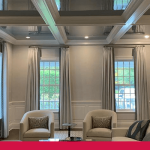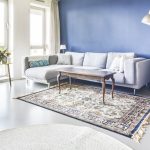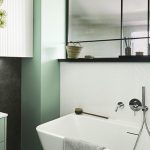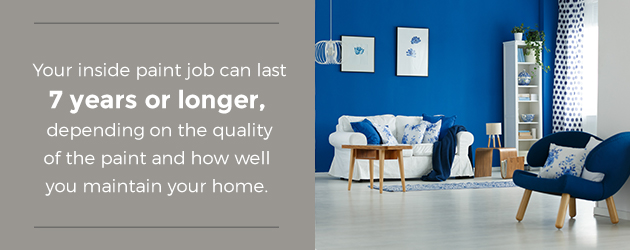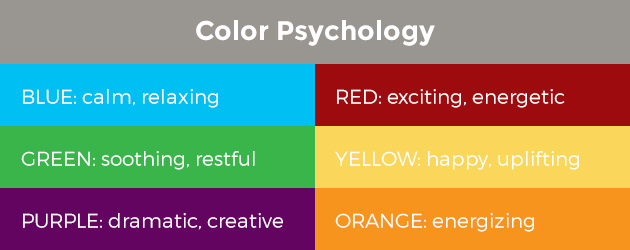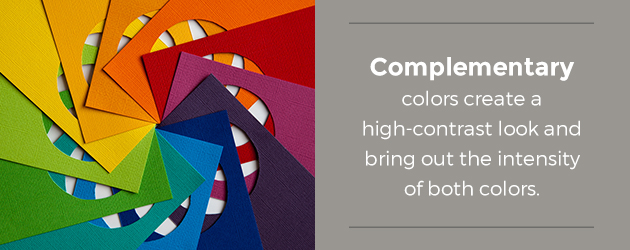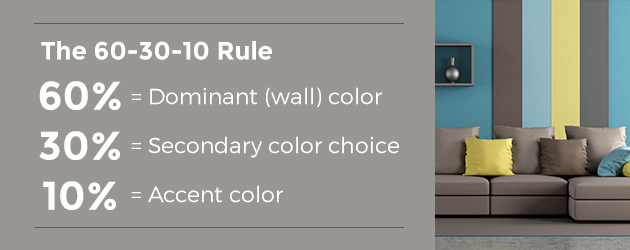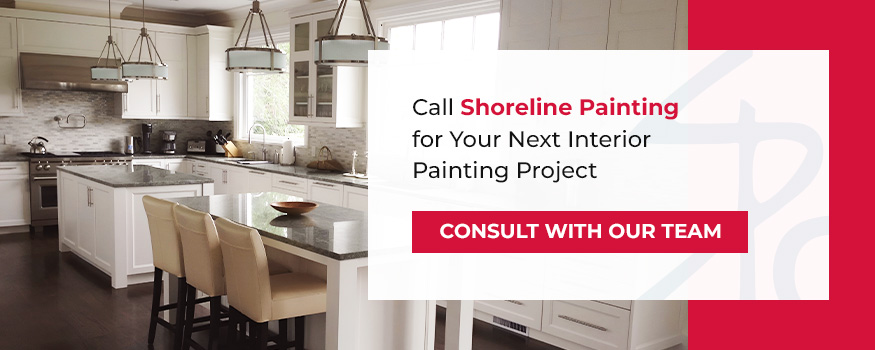Guide to Choosing an Interior Paint Color
August 20, 2024
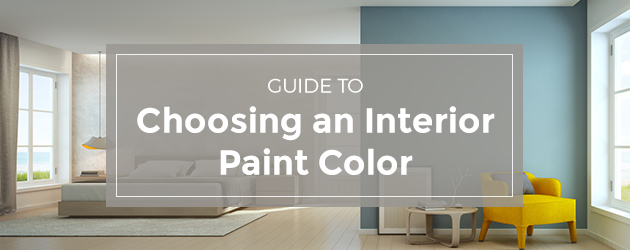
Painting an interior room seems like a great idea until you’re surrounded by paint chips with no clear winner in the color selection process. Don’t let the hundreds of paint options deter you from your ultimate goal of creating a beautiful space you love. New interior paint refreshes your space, giving it an updated look that fits your style. So how do you narrow down all those options? Use our methods of choosing interior paint colors to find the perfect hue for every space. Or if you’re looking for a professional to help you choose check out our color consulting services.
Why Your Interior Paint Choice Matters
Interior walls are relatively easy to paint. If you don’t like the results, you can repaint. Since interiors have more walls to separate spaces, you don’t have to redo everything, unlike exterior paint jobs where you have to do everything at once. That makes choosing interior paint colors a little easier than choosing exterior paint colors, but it’s still a decision you want to consider carefully.
Why does it matter? Room color has a major impact on your home. Consider the following reasons why interior color choice is important.
- Large space: The walls make up the entire perimeter of your room from floor to ceiling. That’s a lot of surfaces covered by your selected paint color. If it’s not an appealing hue, it’s going to stand out in a big way.
- Room ambiance: Color plays a role in setting the mood. If you want a calm, soothing bathroom space for relaxation after work, you don’t want to choose a bright, energetic, vibrant wall color. The mood a color sets can sometimes be subtle, so it’s important to consider the traits before changing your walls.
- Resale value: You may be planning to stay in your home forever, but if you’re planning to move anytime soon, your home’s resale value is important to you. Bold or unusual colors can make your home less appealing to potential buyers.
- Coordinated look: Your room already has furniture, architectural features and other permanent fixtures in it. Your paint color selection helps create a cohesive look in your space, instead of letting the colors clash or compete.
- Personal appeal: You spend a lot of time in your home. You want colors you enjoy looking at, and that make you feel comfortable. Designers use many tricks to choose paint colors, but, ultimately, you need to pick something you can stand staring at every day.
Interior wall paint tends to hold up well because it’s not exposed to the natural elements like exterior paint. Your inside paint job can last seven years or longer, depending on the quality of the paint and how well you maintain your home. Some people choose to repaint more frequently because they’re bored with the old color or the existing paint starts showing signs of wear, like scuffs, peeling or other damage. The timeline is up to you, but choosing colors you love that fit your space every time you paint makes your space comfortable until your next makeover.
What to Consider When Choosing Interior Paint Colors
Use Color Psychology When Choosing Interior Colors
Choosing the best colors for walls often comes down to how you want a certain room to make you feel. Paint color may seem purely aesthetic, but the hues you use on your walls can affect how you feel and how comfortable the room is. Color psychology means each hue tends to create a certain response in people. Using those principles helps you weed out colors to find the best fit for your space.
Consider the following colors and how they influence a room.
- Blue: Shades of blue tend to create a calm, relaxing feeling, but bold blues like sapphire can energize your space. Use lighter blues to make your room feel larger than it is. Because it’s a cool color, blue can make your home feel a bit chilly or uninviting. Pair it with warm colors or choose a warmer blue color like periwinkle or cerulean.
- Green: This earthy color is another calming, soothing paint choice that works well in almost any space. Green tends to have a restful effect on the eye and may help reduce your stress. You can also find shades like emerald that create a dramatic look. Lime green works well when you want to energize a room.
- Purple: Like other colors, the specific purple hue you choose affects the feeling it creates. Light purple tends to have a relaxing effect similar to blue, but doesn’t create the potentially cold feeling. Dark purple creates a dramatic, sophisticated look that evokes luxury, creativity and a royal feeling.
- Red: Bold red falls into the warm color category. It brings an exciting, adrenaline-pumping effect that adds energy to the space. It also has a reputation for sparking conversation, which is ideal for a living room or dining room. Because of its stimulating effect, red is usually not the best option for a bedroom.
- Yellow: A yellow room carries a happy, energizing, uplifting tone. Despite its sunny disposition, yellow may cause people to lose their cool if it’s the dominant color.
- Orange: Another energizing color, orange is best for spaces like exercise rooms where you want a high energy level. The color offers an exciting vibe.
Remember the Color Wheel When Choosing Colors
If you haven’t seen a color wheel since your elementary school art days, it’s time to get reacquainted. The hues fall into place on the diagram in a specific way to show how they relate. Using a color wheel helps you find colors that go well together.
The three primary colors of red, yellow and blue sit at 12 o’clock, 4 o’clock and 8 o’clock on the color wheel. The three secondary colors, or those you can create by mixing primary colors, fall between the two colors used. Orange is between red and yellow, for instance. Green sits between yellow and blue, and purple falls between red and blue. Mixing a secondary color and a primary color gives you a tertiary color — the resulting color falling between them. Blue-green appears between blue, the primary color, and green, the secondary color. There are six tertiary colors.
You can use the color wheel in a few different ways. Here are ideas for some color scheme options.
- Monochromatic: A monochromatic color scheme means you choose different intensities of the same color.
- Analogous: An analogous color scheme includes anywhere from two to six colors that lie next to one another on the color wheel. This type of color scheme usually creates a casual and relaxing feeling in the room.
- Complementary: This option uses two colors that are directly across from one another on the color wheel, such as yellow and purple or green and red. Complementary colors create a high-contrast look and bring out the intensity of both colors.
- Triad: As the name suggests, this option uses three colors. They form a triangular pattern on the wheel, with one color on each angle of the triangle. Green, orange and purple make up a triad. Because of the way the colors relate, this approach creates a balanced look. It’s also a bold option and may not be your best choice if you want something subdued.
Consider Interior Room Elements & Features
Unless you’re gutting your room, you’ll have some existing elements that will stay. Take those features into account when you’re looking at potential paint options. Your new colors should work well with existing elements that won’t change, including furniture, trim, ceiling color, architectural features, flooring, lighting, curtains and decorative items you plan to keep.
You may find a color in one of your existing pieces that inspires your wall color. One trick is to choose a color from a patterned piece in the room, like a rug or upholstery. If you prefer a neutral wall option, focus on the neutral colors within that pattern. Pull a gray, white, beige or similar neutral color from the design as your wall color. The brighter colors in the pattern can work for other design elements in the room or an accent wall color.
Identify Focal Points & Accent Walls
Look around your room. What do you want to emphasize? Does the room have a fireplace or a unique arched doorway? Do you have an amazing view through a large window in the space? Use that focal point as your inspiration for choosing your room colors. Choose colors that complement those features and make them stand out. One option is to choose two colors that work well together. Paint the area near a focal point a vivid, bold color that grabs your attention, while leaving the rest of the room a softer color or a neutral shade. If your room is lacking in architectural interest, you can create your own by choosing one accent wall in a bold color. Add artwork, a beautiful furniture piece or another interesting item on the wall.
Look at Adjoining Rooms & Coordinate Color Schemes
The room you’re painting is your primary focus when choosing colors, but nearby rooms also play a role in the process. Considering adjoining rooms is especially important in a home with an open floor plan that has clear sight lines between spaces. Another area where the adjoining space matters is a room off a hallway, such as a bedroom. When the bedroom door is open, you can see the colors of both the hallway walls and bedroom walls. Select a color that works with the existing colors in nearby rooms to avoid a mismatched, clashing look.
Balance Your Chosen Interior Paint Colors
A good balance of colors keeps the room from overwhelming the senses. One way designers achieve balance is by using the 60-30-10 rule for choosing room colors. The idea behind the principle is that most rooms feature a breakdown of components. Wall space takes up about 60 percent of the room. Furniture, rugs and other pieces account for 30 percent. The remaining 10 percent goes to artwork, decor and other accents. Designers follow those same percentages for balancing color in the room. The dominant color, usually the wall paint color, represents 60 percent of the room. A secondary color choice takes up 30 percent of the room. The final 10 percent is the accent color.
When choosing the colors, look for contrast to make the room interesting. If you go with a light color on your walls, add something bold in your accents. Choosing both warm and cool colors for the space helps create balance and contrast. Adding a warm color to a room with a dominant cool color can help warm up the space and make it more inviting.
Consider Your Interior Ceiling Color
Most people go with a standard white ceiling, but changing up that tradition can give your room a unique look. If you want the space to look larger and airy, it’s best to choose a ceiling color that is lighter than your wall color, even if that color isn’t white. One popular trick is to use the wall color in a lighter shade for the ceiling. By minimizing the contrast between the wall and ceiling color, your room may feel even bigger than it would with a white ceiling.
In a large room, you may want the opposite effect. Choosing a darker color makes it seem lower. When you’re going for a cozy, intimate feel, a lowered ceiling effect can help you create that mood.
Places to Find Inspiration for Interior Color Choices
If you’re still stuck on color choice, find some inspiration around you. Ultimately, you need a color you love. Even though painting a room is relatively easy, it’s not something you want to redo right away if you decide the color isn’t for you.
Look for paint color inspiration in the following places:
- Your home: Look around the rooms in your home to find the pieces you love like pieces of art or a favorite throw pillow. Pick colors from your favorite items. They could be potential paint colors just waiting to be discovered.
- Friends’ homes: The next time you visit a friend or neighbor, pay attention to their wall colors. Do any stand out as something you would like in your home? You may also discover colors you don’t want in your home. Snap a photo to remember the color.
- Your closet: It may sound strange to look at your clothes for inspiration, but it can be the perfect option. You choose your clothes because you feel good in them and like the colors. Since the colors complement you well and you enjoy looking at them, it makes sense to use them in your home.
- Magazines: Check out the plethora of home magazines the next time you’re at the store. You may find inspiration on the glossy pages.
- Browsing online: If you’re not near the magazine aisle, check out on-trend color options from the comfort of your home online. Head to Pinterest for endless examples of room colors and designs. You can also check out the many home improvement blogs and design sites available. Some allow users to upload their own images, which gives you a real-world look at different room options.
- Nature: Sometimes Mother Nature offers the best inspiration for home decor. Look for colors or combinations of hues that appeal to you in your natural environment. Using colors from your local environment inside the home can create a stronger connection to nature.
- Experts: Since you don’t make paint decisions for a living, you may want a little help from a pro. An interior designer or your selected painting service can help you narrow down your choices.
Let Shoreline Painting Help
What are the best interior paint colors for your upcoming project? If you’re still not sure, let Shoreline Painting help. We can guide you through the color selection process to make sure your room turns out beautiful and just the way you want it. Contact Shoreline Painting to get started on your interior painting project. We proudly serve residents of Fairfield County, CT, Westchester County, NY and the surrounding areas.
Recent Posts & Guides
